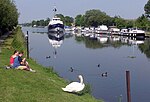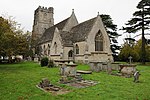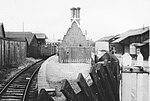Cam and Dursley railway station
DfT Category F2 stationsDursleyPages with no open date in Infobox stationRailway stations in GloucestershireRailway stations in Great Britain opened in 1994 ... and 4 more
Railway stations opened by RailtrackRailway stations served by Great Western RailwayStroud DistrictUse British English from January 2017

Cam and Dursley railway station is a railway station serving the village of Cam and the town of Dursley in Gloucestershire, England. It is located on the main Bristol-Birmingham line, between Yate and Gloucester, at a site close to where Coaley Junction railway station was situated from 1856 to 1965.
Excerpt from the Wikipedia article Cam and Dursley railway station (License: CC BY-SA 3.0, Authors, Images).Cam and Dursley railway station
Box Road,
Geographical coordinates (GPS) Address Nearby Places Show on map
Geographical coordinates (GPS)
| Latitude | Longitude |
|---|---|
| N 51.718 ° | E -2.359 ° |
Address
1
Box Road
GL11 5DJ , Cam
England, United Kingdom
Open on Google Maps










